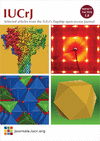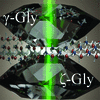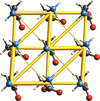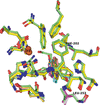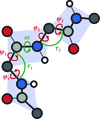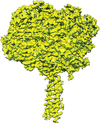issue contents
September 2017 issue

editorial
GENERAL
The IUCr, which was established 70 years ago, will be celebrating 70 years of peer-reviewed publications in 2018. Three of its journals, including IUCrJ, are ranked in the top 10% of all journals, with the remainder striving to be in the top quartile in the next five years.
scientific commentaries
MATERIALS | COMPUTATION
Two recent systematic determinations of bond-valence parameters addressed the problem of the correlation between R0 and b in different ways raising the question of which is to be preferred.
BIOLOGY | MEDICINE
A synopsis of and prospects for de novo phasing using diffraction data collected at X-ray free-electron lasers are given.
topical reviews
BIOLOGY | MEDICINE
Small-angle X-ray scattering (SAXS) is an established technique that provides low-resolution structural information on macromolecular solutions. This review illustrates the latest progress in the field, highlighting analytical methods for flexible and evolving systems, progress in time-resolved SAXS and developments in archiving and validation.
PHYSICS | FELS
Recent developments in protein microcrystallography using synchrotron radiation are reviewed, including the use of a high-flux microbeam, consideration of radiation damage, sample-handling techniques, and data-collection strategies and their automation.
MATERIALS | COMPUTATION
This topical review presents developments in the analysis of functional energy materials using real-time operando X-ray and neutron powder diffraction of non-equilibrium systems. Examples in the areas of porous framework materials and rechargeable battery electrodes are used to highlight improvements in structural detail gained for guest–host systems through advances in instrumentation and experimental approach.
research letters
NEUTRON | SYNCHROTRON
Using high-brilliance high-energy synchrotron X-ray radiation, for the first time a robust pair distribution function signal has been collected, in transmission mode, on a weakly scattering amorphous organic thin film deposited on a borosilicate glass substrate.
PHYSICS | FELS
The optimal XFEL pulse duration for single-particle imaging of small proteins is narrowed down to the 3–9 fs range, using start-to-end simulations of a single-particle imaging experiment at the European XFEL.
CHEMISTRY | CRYSTENG
Download citation


Download citation


The structure of the ζ polymorph of glycine has been solved by a combination of crystal structure prediction and neutron powder diffraction, where the elusive phase was trapped at low temperature. At room temperature ζ-glycine is a short-lived intermediate in the pressure-driven transition between the ɛ and γ polymorphs; by contrast at low temperature it undergoes the first observed transformation into the metastable β polymorph.
research papers
CHEMISTRY | CRYSTENG
The accurate and efficient CE-B3LYP and CE-HF model energies for intermolecular interactions in molecular crystals are extended to a broad range of crystals by calibration against density functional results for molecule/ion pairs extracted from 171 crystal structures. The mean absolute deviation of CE-B3LYP model energies from DFT values is a modest 2.4 kJ mol−1 for pairwise energies that span a range of 3.75 MJ mol−1.
MATERIALS | COMPUTATION
Download citation


Download citation


A comparison is made of information on the structural aspects of the displacive dehydration of samarium oxalate decahydrate obtained from optical microscopy observations and X-ray diffraction studies.
MATERIALS | COMPUTATION
Spin-reorientation magnetic transitions are studied in Mn-doped SmFeO3.
NEUTRON | SYNCHROTRON
A new technique is presented to allow the measurement of weakly scattering samples despite a high-background environment. Coherent interference between the sample and a nanofabricated `amplifier' structure generates a strong interference scattering pattern, which can be analyzed using angular correlation functions to reconstruct the sample's symmetry.
MATERIALS | COMPUTATION
Consistent sets of bond-valence parameters comprising 706 types of cation–anion pairs are derived and evaluated with respect to the impact of variable bond softness b, the first coordination shell convention and an unbiased determination of the cation coordination number.
BIOLOGY | MEDICINE
An algorithm for modelling the background of X-ray diffraction images in the presence of ice rings is presented.
BIOLOGY | MEDICINE
High-energy X-rays are essential for de novo structure determination with strong anomalous scattering from selenium or mercury. Single-wavelength anomalous diffraction phasing using selenomethionine-derivatization and mercury-soaking techniques has been successfully applied to serial femtosecond crystallography with 13.0 keV or 12.6 keV X-rays produced at SACLA.
BIOLOGY | MEDICINE
Rieske nonheme iron oxygenases often catalyze different reactions when different substrates bind to them. From the structures of complexes of naphthalene 1,2-dioxygenase with substrates that result in different types of products, it is shown that the binding orientation of the substrate not only dictates regioselectivity and stereospecificity, but also determines the type of reaction that is catalyzed.
PDB references: NDO, complex with 1-chloronaphthalene, 4hjl; complex with benzamide, 4hkv; complex with indole-3-acetate, 4hm0; complex with ethylphenylsulfide, 4hm2; complex with ethylbenzene, 4hm3; complex with indan, 4hm4; complex with indene, 4hm5; complex with phenetole, 4hm6; complex with styrene, 4hm7; complex with thioanisole, 4hm8
BIOLOGY | MEDICINE
The conformation of the protein main chain is described in a novel three-dimensional space derived from the interatomic distances. This allows the local and overall validation of protein backbone geometry and the detection of residues that are strained for reasons of their function.
CHEMISTRY | CRYSTENG
Download citation


Download citation


A closer look into close packing: pentacoordinated silicon in a high-pressure polymorph of danburite
High-pressure single-crystal X-ray diffraction study of danburite, CaB2Si2O8, has revealed that it is the first compound showing a step-wise transition of Si coordination from tetrahedral to octahedral through trigonal bipyramidal. Along the compression, the Si2O7 groups of danburite first transform into chains of vertice-sharing SiO5 trigonal bipyramids (danburite-II) and later into chains of edge-sharing SiO6 octahedra (danburite-III).
CRYO | EM
Download citation


Download citation


An efficient and fast pipeline is presented for obtaining near-atomic resolution structures from large single-particle cryo-EM data sets. The approach is virtually reference-free and is therefore less prone to the perils of reference bias.
PDB reference: Lumbricus terrestris haemoglobin, 5m3l
MATERIALS | COMPUTATION
Taking 4-(1,2,2-triphenylvinyl)aniline salicylaldehyde hydrazone (A) as an example, the relationship between molecular packing and charge-transport parameters has been computed and analysed. The conducting properties of A are also predicted within the framework of hopping models.
MATERIALS | COMPUTATION
The martensitic transformation orientation relationship (OR), the transformation deformation and their impact on variant organization in an Ni50Mn38Sb12 alloy have been thoroughly studied by scanning electron microscopy/electron backscatter diffraction (SEM/EBSD), as they are decisive factors for mechanical and magnetic properties. The transformation OR has been identified and the consequent hierarchical organization of martensite variants has been fully revealed.



 journal menu
journal menu




 access
access



